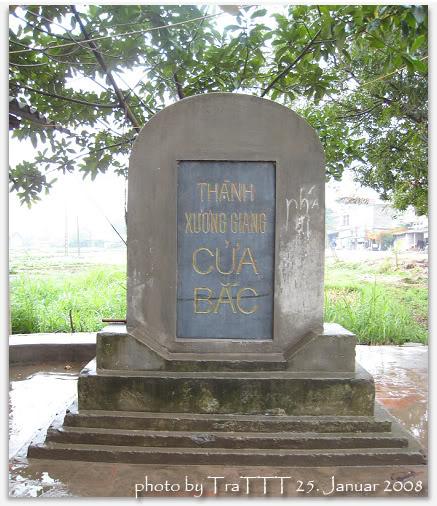Xuong Giang is the name of an ancient citadel located in the Northeast of Bac Giang city, 3km from the Thuong river bridge. Formerly Xuong Giang was in Dong Nham commune, Tho Xuong province. Because it is located at the end of the commune, Xuong Giang to the northeast is adjacent to Tan Dinh commune (Lang Giang district); the southeast borders Dinh Ke commune (Bac Giang city), the west is the And and field fields, the north is Thanh village and Xuong Giang commune.
According to the documents and bibliographies we know, after the invasion of our country, the Ming established defenses and built strongholds in key places to defend. Xuong Giang was built during this period, in 1407 when the Ming Dynasty established Changjiang. It became the headquarters of the government of Lang Giang, including the districts of Lang Giang (the old Bao Loc), Yen Dung, Yen The, Luc Ngan of Bac Giang province, Huu Lung of Lang Son province and was the most fortified fortress of the enemy. language on the road of the station connecting Guangxi (China) with Dongguan. This is a fairly large citadel built on a high ground that at the foot of the low hills are tributaries of the Thuong River, named Cau Do and Cau Thao Rivers. The wall is filled with rectangular soil. The length of the east-west direction is 600m, the width of the north-south direction is 450m. Area of about 27ha (equivalent to nearly 70 acres of the North). Walls made of high and thick soil. The four corners of the four fortresses are about 4m higher than the walls. Outside the moat is surrounded by deep moat. At present, there are traces of sincerity, but the sincere northeast is still 25m wide. The other side has a width of up to 20m and 4m higher than the field. Particularly the west coast is almost completely leveled. The moat surrounding the city has been almost all leveled for farming. However, the remaining traces are still up to 15 meters wide and up to 1m deep. The castle consists of four doors in four directions. The main door looks to the west, now only the east door remains. At each gate, there is a round field, more than 1 sao wide, shoulder-deep, people still call it "military battle". The city's drainage route flows through the southern and western gates.
In the city divided into areas, headquarters, barracks, salaries, prisons ... In the inner city today there are still many different high and low mounds, the highest is the "hill army" (or King). ) Maize "is located a little northeast. The perimeter of about 300m belongs to Ha Vi village (divided after the city was liberated). Food stores for weapons and military barracks were built around the "Ngo hill" area near the northern bank. This is determined by the cultivation process, local people also dug up quite a lot of burnt rice into charcoal, large boulders, rock bullets of various sizes and sizes. from 3cm to 12cm. These artifacts are being kept by the local Museum. Stone bullets are found in the northeast corner and northwest corner of the city, lying in the ash ash next to the sincere. Along with the stone bullets also found the footsteps of the column are also of stone. The number of millet is quite numerous, including many large and small types. The millet is made of rectangular rock salt or limestone with dimensions from 60 cm to 100 cm in length, 40 - 50 cm in width, 30 - 40 cm thick. In addition, there are many terracotta artifacts in the city such as bricks, tiles, crockery, porcelain ...
Brick found quite a lot on the wall, in the walls and in the soil layers inside and outside the city. The bricks found include many different types of large and small, also different shapes, often red or gray. The bricks are usually not patterned. These bricks belong to the Le Dynasty, often found in the relics of Lam Son (Thanh Hoa) and Chi Lang (Lang Son). The bricks found in Changjiang are the architectural constructions built inside the citadel.
Through the remaining traces, we can affirm that Xuong Giang is an important historical site. This place before the citadel had been a big meeting place since the Ly - Tran dynasty with the destroyed buildings. In addition, many other relics show that right from the early centuries of BC and during the time of our country's rule, northern feudalists occupied Xuong Giang. When the Ming army invaded, they built the citadel right on the ancient ruins of the Ly - Tran Dynasty. And the land of residence of the Ly - Tran dynasty was dug up to form a wall, leading to the phenomenon of artifacts of many eras piling up. However, the imprint of the citadel and the relics found were the evidence of a glorious historical period: “The period of siege and lowering of Xuong Giang citadel moved to destroy the entire army of Minh army. 1427. The victory successfully ended the war of national liberation in the early 15th century of our nation
Currently, Bac Giang City People's Committee is implementing the first phase of the Conservation, Embellishment and Promoting Project of Xuong Giang Victory Historic Site. Complex of relics including the Victory Monument Xuong Giang, Souvenir House, Square.
(Source: bacgiang.gov.vn)